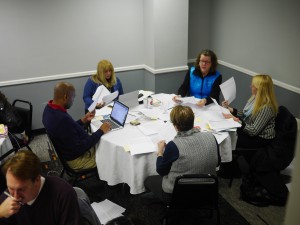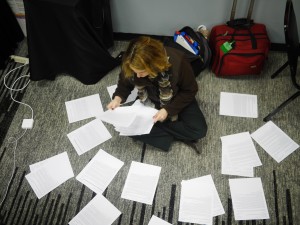 This is one of the more exciting weeks each year in life of NCTE. In the space of four energetic days in Washington, DC, three things happen: Advocacy Day, an Executive Committee meeting, and Annual Convention Planning. Last year we were greeted by a snowstorm that shut the federal government; I’ll be happy not to have that drama this time around. I’ll tell you about each of these activities, starting in this post with the convention planning process.
This is one of the more exciting weeks each year in life of NCTE. In the space of four energetic days in Washington, DC, three things happen: Advocacy Day, an Executive Committee meeting, and Annual Convention Planning. Last year we were greeted by a snowstorm that shut the federal government; I’ll be happy not to have that drama this time around. I’ll tell you about each of these activities, starting in this post with the convention planning process.
The process of building the annual convention has three review levels built into it, the most important of which happens before the face-to-face convention planning meeting.
Level One
Let’s imagine that by the January 2016 deadline, you submitted a proposal for “The Apostrophe: Legend, Lore, and Legacy,” and you’ve indicated the main interest audience as Secondary. Your proposal will have been sent, electronically, to two readers in a group of reviewers designated by the Secondary Section Steering Committee or its Chair. (If you had indicated the audience as elementary, middle, college, general, research, or English educators, your proposal would be read by folks from a pool of reviewers designated by each of those groups.)
Your proposal gets rated on four criteria and receives an overall rating from each reviewer. Reviewers also write brief comments. Let’s imagine that your proposal on “The Apostrophe” receives an overall rating of 3 from each online reviewer, for a total rating of 6. All of the ratings and comments for your proposal are gathered and made available to (in your case) a Secondary Section team of two people who are meeting in Washington, DC, along with other review teams.
Prior to that meeting, the convention Program Chair (this year, that’s Susan Houser), has worked with NCTE staff to analyze the proposals and determine how many program slots are available and how they will be allocated. Let’s imagine there are 500 session slots available at the convention. (The number of slots is determined by the number of meeting rooms in the convention center/hotel times the number of session times.) Let’s imagine that there are 2000 total proposals. Historically, NCTE has allocated the number of sessions proportionally to the number of submissions in each are. (There’s one other consideration, but let’s keep things simple.) An illustration makes it clear.
Suppose those 2000 proposals break down this way:
Elementary Section: 400 (20%)
Middle Section: 400 (20%)
Secondary Section: 600 (30%)
College Section: 100 (5%)
General: 300 (15%)
Research: 100 (5%)
English Education: 100 (5%)
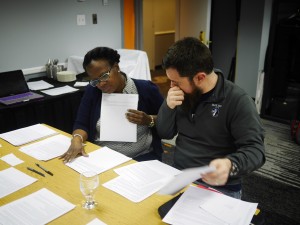 Level Two
Level Two
So, your proposal on “The Apostrophe” is in a pool from which roughly 30% of the convention slots are allocated. 30% of 500 slots is 150. The Secondary reviewers in Washington, then, are trying to determine whether your proposal should earn one of those 150 spaces on the program. Generally, everything with a total rating of 8 is accepted. Generally, so is everything with a rating of 7. But, generally, everything with a total rating of 2, 3, or 4 is not. That leaves a number of proposals with ratings of 5, 6, or sometimes 7 left. There’s not room for all. The review team, then, has to exercise some judgment. They skim the remaining proposals to double-check the online ratings. They look at the comments. They look at the topics and judge which of them might contribute most to the overall program. They combine significant individual presentations into panels with similar individual presentations. In short, they use their very best judgment to decide which are the best 150 proposals from their group.
Level Three
Remember how above I mentioned there is one other consideration? Well, here’s that layer. Many years ago, NCTE determined it was vital to ensure convention space for matters of central importance to our members and mission. As a result, for example, we allocate a certain number of sessions for the Rainbow Strand (issues and strategies related to teaching and affirming culturally and linguistically diverse students), or for Whole Language, for the LBGT Strand, and so on.
When people write convention proposals, they’re invited to identify their proposals as meeting one of these designated foci or interests. A large number of proposals so designated are accepted, of course, through the Level Two process I described above. But space is limited. The Strand Review process provides another route.
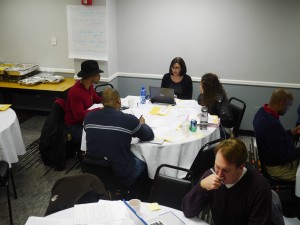 Let’s imagine that you checked “Whole Language” for your proposal on “The Apostrophe” because you were emphasizing ways of teaching this kind of punctuation that fit the principles of whole language instruction. (Humor me!) Let’s imagine, further, that the Secondary group determined that your proposal wasn’t one of the 150 it could accept. But there’s also a Whole Language review team, which convenes along with other review groups. They look at all of the Whole Language-designated proposals and choose those that best meet the spirit of the strand. They, like the other Strand groups, have an allotment of program slots they can fill (let’s imagine 10 of them) above and beyond the ones apportioned previously. Of course, your “Apostrophe” proposal may well have been accepted by the Secondary group. Congratulations! If the Whole Language reviewers agree that it meets their criteria, it will show up in the program with the strand designation, and they’ll be able to use their program slots for something else.
Let’s imagine that you checked “Whole Language” for your proposal on “The Apostrophe” because you were emphasizing ways of teaching this kind of punctuation that fit the principles of whole language instruction. (Humor me!) Let’s imagine, further, that the Secondary group determined that your proposal wasn’t one of the 150 it could accept. But there’s also a Whole Language review team, which convenes along with other review groups. They look at all of the Whole Language-designated proposals and choose those that best meet the spirit of the strand. They, like the other Strand groups, have an allotment of program slots they can fill (let’s imagine 10 of them) above and beyond the ones apportioned previously. Of course, your “Apostrophe” proposal may well have been accepted by the Secondary group. Congratulations! If the Whole Language reviewers agree that it meets their criteria, it will show up in the program with the strand designation, and they’ll be able to use their program slots for something else.
The Upshot
Picture, then, a basement hotel conference room in Washington, DC, this Saturday and Sunday, filled with teams of elected and appointed member volunteers, each pondering sets of proposals—more quality proposals than they can possibly accept. That’s the difficult reality everyone faces. It’s a room filled with conversation, animated by the common desire to put together the very best program, one that represents the multiple interests and 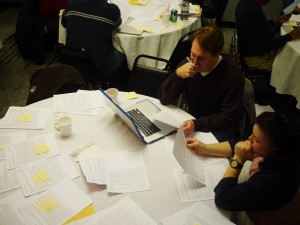 needs of NCTE members.
needs of NCTE members.
Look elsewhere for my posting I’ll talk about Advocacy Day.
–Doug
